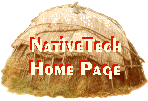
Quill work on bark is an ancient
art, as old or older than sewn quill embroidery, both Native American
traditions for probably thousands of years. Porcupine quill decoration
on bark is not as well know as porcupine quill embroidery on leather,
and compared to sewn embroidery on leather, it is less time consuming
but is admittedly much easier to learn. No needle or thread,
nor any sewing, is necessary to attach porcupine quills to birch
bark.

|
|
CHAIR SEAT & PORTFOLIO - MICMAC [Orchard 1984] |
Natives across North America made a multitude of items by folding and sewing together various types of tree barks like hickory, cedar, elm, ash, oak and others. In the Eastern Woodlands where the paper birch tree (Betula papyrifera) grows, Natives traditionally made all kinds of things from this flexible bark including collecting baskets, serving dishes, eating utensils, and even fans and headbands. As not all bark items were made from birch, not all birch items were decorated with porcupine quills. Elaborate decoration is time consuming, every-day bark items - quick to wear out - are rarely decorated with quills. Special boxes, headbands and fans were more likely to be decorated with porcupine quills.

|
|
INSERTING A QUILL THROUGH BARK |
Much like a staple, either end of each quill passes through perforation made in the bark. Perforations are made with an awl (preferably an awl with a triangular point) in closely-spaced pairs following a pattern laid out with a scribe or marker. The pointed, barbed end of the quill makes a natural needle to thread the quill through the holes in the bark. The layered nature of the birch tree’s bark holds quill in place, especially as the previously soaked quills stiffen as they dry. After each quill is threaded through the pair of holes the ends are bent under on the back side and then usually covered with a liner sewn on to hide and protect the ends of the quills. If the holes in the bark are made small enough, and hold the quills very tightly, expert quill workers will snip off the ends of the quills on the backside of the birch bark. Patterns achieved in placement of the quills in parallel rows, offsetting them slightly, or crossing the quills into stars or fans give the decorated bark an elegant look of embroidery, and uses many similar stitches.

|
|
& WOVEN QUILLS AROUND THE LID - MICMAC [Bock 1978] |
Though quill decoration on was known to all groups of Native Americans living in the range of porcupine, a few groups of eastern Woodland Natives are particularly well known for decoration on birch bark. "The Iroquois, for instance, did little of this while the excellence of Micmac quilled boxes sets the standard for the craft. The Ottawa and Ojibwa became quite proficient, and most quilled boxes today come from isolated groups such as the Ojibwa in Canadian reserves." (Schneider 1972).Among the most notable are quill-decorated items made by the Micmac, Passamaquoddy, Penobscot, Beothuk, Ojibwa, and Ottawa living in the regions of New England, the Great Lakes, Nova Scotia, Newfoundland, New Brunswick, Ontario and other areas of eastern North America [Orchard 1984].
Return to NativeTech's Main Porcupine Quillwork Menu

|
Text and Graphics
© 1994 - Tara Prindle unless otherwise cited. |